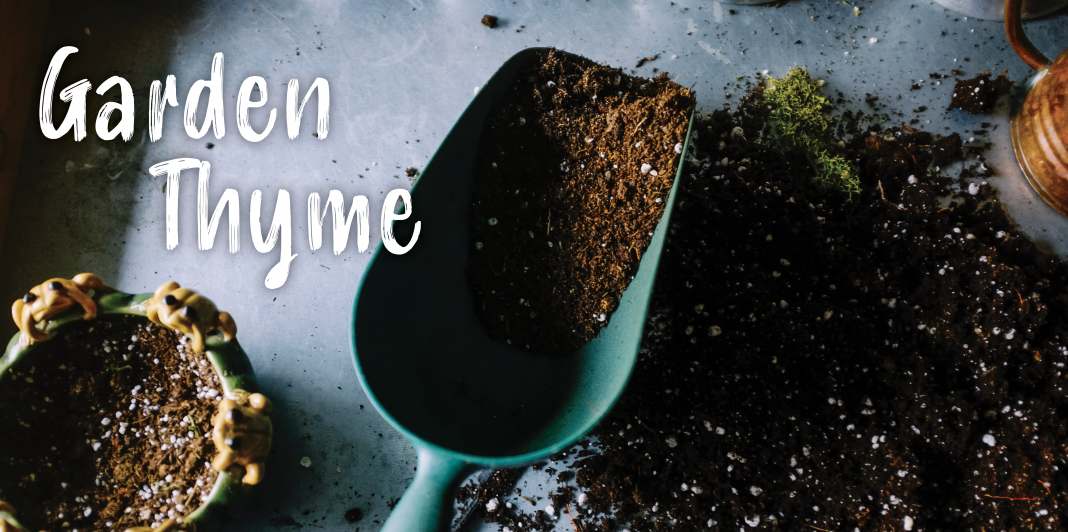Garden Thyme: How to Start a Kitchen Herb Garden
As fresh herbs are growing in popularity, they can put a dent in your grocery list when buying the plastic containers at the store. If you’ve bought them in the past, you know the frustration of only using a small amount and watching the rest go bad in your fridge. Despite their high prices— whether you’ve got a green, brown or black thumb—herbs are easy to grow and care for.
First, let’s talk about a few things you’ll need to know about growing an herb garden.
Herbs Love the Outdoors
While herbs can technically grow inside or outside, these sun-loving plants prefer to be outside soaking up all the UV rays they can get. This means that on average, herbs prefer to get 6 hours of direct sunlight per day. Not only that, oftentimes the climate of our homes are pretty dry, opening them up to stress and pesticides.
If you have no choice but to grow them inside, put them in the brightest area of your home, even if it’s a bit inconvenient. However, if you’re growing your plants indoors—keep in mind that they grow year-round, and during the winter your indoor herbs won’t get enough sunlight. If all else fails, there are plant lights that are timed to replicate ideal lighting conditions.
Don’t Start from Seeds
If you’re a gardening newbie, seeds are a bit more complicated, taking more time and patience. It’s best to start with a store-bought plant trimming. You can grow herbs from trimmings in a few simple steps.
First, snip a 3 to 4 inch long piece, and make sure to cut the plant right under where the leaf comes out of the stem. Remove the bottom leaves and put your trimming into water. After 2 or 3 weeks you’ll begin to see roots growing. Once you see those roots, it’s ready to plant! Take a pot filled with loose compost and plant the trimming in, pressing the compost down firmly around it. Give it some water and then watch your herb come to life!
Pay Attention to Soil Conditions
Depending on the type, herbs have different preferences on the condition of their soil. Rosemary, Lavender and Thyme do well in drier soil, while Mint, Basil and Chives grow best with plenty of water. You might place these herbs into separate groups in your garden as a reminder of which ones need more water.
Now that you’ve got the basics down, let’s talk about some easy and useful herbs to start off with!
Sage
Sage hails from the Mediterranean region, and the drought tolerant herb prefers mild winters and warmer summers. The leaves can be used all year round in dishes like poultry, pork, sausage and Italian seasonings. Its flowers are edible and can be eaten in salads or fruit puddings. Sage can also be used in soups, sauces, sourdough bread, and with roasted veggies.
To care for Sage, trim the herb back after flowering in summer to keep it from becoming woody, and new growth will appear. An insect called Leafhopper can occasionally feed on the plant sap of Sage. If the leaves become damaged because of this insect, simply remove them. If your Sage plant is in a pot and becomes overtaken by mildew, move the plant to an airier section, removing any damaged leaves.
Rosemary
Similar to Sage, Rosemary is a drought tolerant herb from the Mediterranean that can be used in your favorite chicken noodle soup recipe. Along with soups—Rosemary goes well in stews, cassaroles, salads, and several meats—chicken being the most popular. The smell of Rosemary is also a favorite aroma of many and can be used around the house instead of flowers.
Rosemary is an evergreen plant growing throughout the year. Whether in a garden or a pot—the herb grows best in a warm and sunny area with well-drained soil since the herb prefers the drier climate. The plant can become woody, and in order to prevent this you can trim it back after the flowering stage. If Rosemary beetles begin to swarm the plant, you can gently shake them off of the stems by tapping on the plant. Placing something underneath the plant like a paper towel will make catching the bugs easier.
Mint
This sweet, refreshing herb is a great addition to hot and cold beverages, salads, fruit, desserts and baked goods. Not only that, you can skip the benadryl and laxatives—this herb is a great remedy for sinus congestion, headaches, and it promotes regular digestion! Next time you have a cold, try a hot Mint tea mixed with lemon and honey.
For the best minty flavor, grow your Mint plants in full sun. The herb grows naturally on its own, and can actually become an invasive plant as it spreads. Pots are a great solution to a wild Mint plant, rather than allowing them to take over your other plants in a garden. Mint leaves can be picked after the flowering stage or after it has been cut back in the summer.
Thyme
Thyme is another favorite herb—not only because it rhymes with time—but it is versatile in its uses. The herb can be used in foods like sauces, marinades, soup, eggs, baked goods and more. The evergreen plant can also be used to treat bacterial and fungal infections and has an antioxidant effect which promotes respiratory health.
To care for Thyme, remember that the herb prefers drier soil, and keep it in a sunny spot, making sure it is well drained. To survive the winter, this plant needs to be cut back after flowering. Fortunately this plant rarely suffers from pests, with the minor exception of aphids. These can be taken care of by spraying the plant with horticultural soap.















